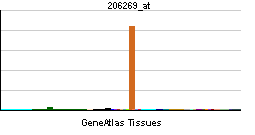GCM1
| Glial cells missing homolog 1 (Drosophila) | |||||||||||||
|---|---|---|---|---|---|---|---|---|---|---|---|---|---|
 PDB rendering based on 1odh. | |||||||||||||
| |||||||||||||
| Identifiers | |||||||||||||
| Symbols | GCM1 ; GCMA; hGCMa | ||||||||||||
| External IDs | Template:OMIM5 Template:MGI HomoloGene: 2702 | ||||||||||||
| |||||||||||||
| RNA expression pattern | |||||||||||||
 | |||||||||||||
| More reference expression data | |||||||||||||
| Orthologs | |||||||||||||
| Template:GNF Ortholog box | |||||||||||||
| Species | Human | Mouse | |||||||||||
| Entrez | n/a | n/a | |||||||||||
| Ensembl | n/a | n/a | |||||||||||
| UniProt | n/a | n/a | |||||||||||
| RefSeq (mRNA) | n/a | n/a | |||||||||||
| RefSeq (protein) | n/a | n/a | |||||||||||
| Location (UCSC) | n/a | n/a | |||||||||||
| PubMed search | n/a | n/a | |||||||||||
Glial cells missing homolog 1 (Drosophila), also known as GCM1, is a human gene.[1]
This gene encodes a DNA-binding protein with a gcm-motif (glial cell missing motif). The encoded protein is a homolog of the Drosophila glial cells missing gene (gcm). This protein binds to the GCM-motif (A/G)CCCGCAT, a novel sequence among known targets of DNA-binding proteins. The N-terminal DNA-binding domain confers the unique DNA-binding activity of this protein.[1]
References
Further reading
- Akiyama Y, Hosoya T, Poole AM, Hotta Y (1997). "The gcm-motif: a novel DNA-binding motif conserved in Drosophila and mammals". Proc. Natl. Acad. Sci. U.S.A. 93 (25): 14912–6. PMID 8962155.
- Yamada K, Ogawa H, Honda S; et al. (1999). "A GCM motif protein is involved in placenta-specific expression of human aromatase gene". J. Biol. Chem. 274 (45): 32279–86. PMID 10542267.
- Nait-Oumesmar B, Copperman AB, Lazzarini RA (2000). "Placental expression and chromosomal localization of the human Gcm 1 gene". J. Histochem. Cytochem. 48 (7): 915–22. PMID 10858268.
- Yamada K, Ogawa H, Tamiya G; et al. (2001). "Genomic organization, chromosomal localization, and the complete 22 kb DNA sequence of the human GCMa/GCM1, a placenta-specific transcription factor gene". Biochem. Biophys. Res. Commun. 278 (1): 134–9. doi:10.1006/bbrc.2000.3775. PMID 11071865.
- Yu C, Shen K, Lin M; et al. (2003). "GCMa regulates the syncytin-mediated trophoblastic fusion". J. Biol. Chem. 277 (51): 50062–8. doi:10.1074/jbc.M209316200. PMID 12397062.
- Strausberg RL, Feingold EA, Grouse LH; et al. (2003). "Generation and initial analysis of more than 15,000 full-length human and mouse cDNA sequences". Proc. Natl. Acad. Sci. U.S.A. 99 (26): 16899–903. doi:10.1073/pnas.242603899. PMID 12477932.
- Mungall AJ, Palmer SA, Sims SK; et al. (2003). "The DNA sequence and analysis of human chromosome 6". Nature. 425 (6960): 805–11. doi:10.1038/nature02055. PMID 14574404.
- Chen CP, Chen CY, Yang YC; et al. (2005). "Decreased placental GCM1 (glial cells missing) gene expression in pre-eclampsia". Placenta. 25 (5): 413–21. doi:10.1016/j.placenta.2003.10.014. PMID 15081636.
- Baczyk D, Satkunaratnam A, Nait-Oumesmar B; et al. (2004). "Complex patterns of GCM1 mRNA and protein in villous and extravillous trophoblast cells of the human placenta". Placenta. 25 (6): 553–9. doi:10.1016/j.placenta.2003.12.004. PMID 15135239.
- Schubert SW, Kardash E, Khan MA; et al. (2005). "Interaction, cooperative promoter modulation, and renal colocalization of GCMa and Pitx2". J. Biol. Chem. 279 (48): 50358–65. doi:10.1074/jbc.M404587200. PMID 15385555.
- Gerhard DS, Wagner L, Feingold EA; et al. (2004). "The status, quality, and expansion of the NIH full-length cDNA project: the Mammalian Gene Collection (MGC)". Genome Res. 14 (10B): 2121–7. doi:10.1101/gr.2596504. PMID 15489334.
- Yang CS, Yu C, Chuang HC; et al. (2005). "FBW2 targets GCMa to the ubiquitin-proteasome degradation system". J. Biol. Chem. 280 (11): 10083–90. doi:10.1074/jbc.M413986200. PMID 15640526.
- Knerr I, Schubert SW, Wich C; et al. (2005). "Stimulation of GCMa and syncytin via cAMP mediated PKA signaling in human trophoblastic cells under normoxic and hypoxic conditions". FEBS Lett. 579 (18): 3991–8. doi:10.1016/j.febslet.2005.06.029. PMID 16004993.
- Chang CW, Chuang HC, Yu C; et al. (2005). "Stimulation of GCMa transcriptional activity by cyclic AMP/protein kinase A signaling is attributed to CBP-mediated acetylation of GCMa". Mol. Cell. Biol. 25 (19): 8401–14. doi:10.1128/MCB.25.19.8401-8414.2005. PMID 16166624.
- Chuang HC, Chang CW, Chang GD; et al. (2006). "Histone deacetylase 3 binds to and regulates the GCMa transcription factor". Nucleic Acids Res. 34 (5): 1459–69. doi:10.1093/nar/gkl048. PMID 16528103.
- Fujito N, Samura O, Miharu N; et al. (2007). "Increased plasma mRNAs of placenta-specific 1 (PLAC1) and glial cells-missing 1 (GCM1) in mothers with pre-eclampsia". Hiroshima J. Med. Sci. 55 (1): 9–15. PMID 16594548.
- Chou CC, Chang C, Liu JH; et al. (2007). "Small ubiquitin-like modifier modification regulates the DNA binding activity of glial cell missing Drosophila homolog a.". J. Biol. Chem. 282 (37): 27239–49. doi:10.1074/jbc.M700351200. PMID 17646165.
| This protein-related article is a stub. You can help Wikipedia by expanding it. |